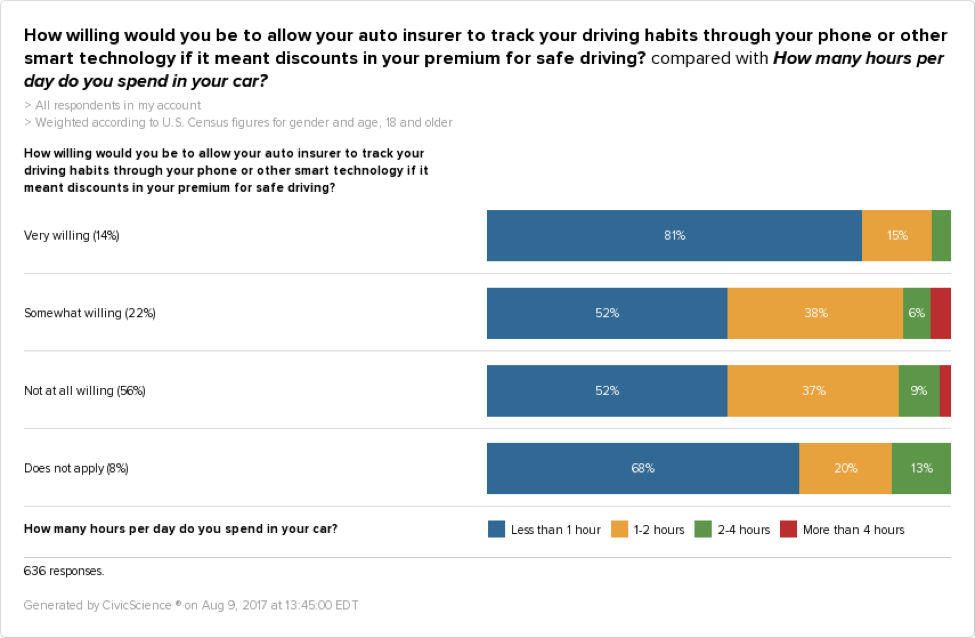Editor’s note: Emma Diehl is engagement specialist at marketing research firm CivicScience, Pittsburgh.
How far would you go to save on auto insurance? Driving safer to save may be a no-brainer but the means to track it has some consumers turned off. Auto insurance companies have started offering drivers discounts for safe driving but drivers must use the tracker provided by the insurer to “ensure” safe driving.
When it comes to using and marketing smart technology, knowing your audience can vastly change the game. In the cause of auto insurance, the idea of tracking is not only a turnoff but perhaps a reason to change insurers. For some, the appeal of saving allays any fears of the tech being used in the car.
Implementing smart trackers
Smart trackers might be the latest tech when it comes to insurance coverage but market researchers should be mindful of the genuine persuadable audience. As technology becomes more and more ubiquitous, researchers need to keep in mind that the latest tech might not be appealing to the traditional tech or early adopters crowd.
In our recent survey on U.S. adults and auto insurance smart trackers, only 16 percent were “very willing” to adopt this technology for potential savings. Fifty-three percent are not at all willing to implement this technology to save on auto insurance. This unwilling group is more likely than the rest to have a household income over $100,000. The remaining 22 percent are somewhat willing to adopt this new tech. This population is more likely to be engaged on social media across all platforms.
But what about the 16 percent who are very willing to use a tracker to save on car insurance? Why does smart technology appeal to them? What can marketing researchers within the auto insurance industry – or those interested in implementing smart trackers in MR studies – learn from these persuadables?
Money mindful
It’s not entirely shocking that those most willing to use a tracker to save on insurance are mindful of the way they spend their money. While not necessarily correlated with income, people who are very willing to use a tracker to save are more likely to manage their money very well.
These consumers are price-conscious, interested in shopping around for the best buy at the best value. Likely, these drivers are drawn to the car tracker not for its exciting technology but for the promise of saving some money on their insurance payments.
In addition to being mindful of spending, consumers who were very willing to use a tracker fell into the following categories:
- Driving American-made: Since our data revolves around driving cars, we thought it’d be worthwhile to check out car preferences. Those most willing to enroll in a car-tracking program are most likely of all drivers to have an American-made car.
- Light drivers: It’s more likely that light drivers will be interested in using a smart tracker. Given that more auto insurers will dispense discounts for lower mileage, this tends to make sense. However, the tracker doesn’t simply log miles. Many of these programs also grade a driver for discounts by what time of day they’ve driven, average speed or braking. It’s a new technology but educating drivers about how it works might help turn the persuadable audience into users.
![]()
- Grandparents: Anyone who has ever handed the car keys over to a new driver knows how important safety is in the car. However, those very willing to adopt this new tech are more likely to be grandparents. While new technology and grandparent don’t always go hand-in-hand, this shows that perhaps the tracker is less of a tech play for consumers. Instead, it’s a tool – in this case, one that ensures safer driving and savings.
I won’t over-speculate but perhaps parents are more concerned about the privacy aspect of having tracking technology in the car. That, and they might not have a kid behind the wheel yet.
![]()
- Cable news followers: So where can advertisers and auto insurance companies find their persuadable audience? People who watch network news – ABC, CBS and NBC – are much more likely to be willing to adopt this driving technology. Appealing to this group with ads on their news program of choice might be the best way to win them over.
It is clear that for this audience the tracker doesn’t come across as the latest gadget but instead a tool to save on insurance payments and promote safer driving overall.
In industries such as auto insurance, with an estimated $200 billion global market, knowing who could be interested in the tech could vastly change marketing techniques. While tracking technology is relatively new, as marketing researchers it is good to have an idea of the persuadable audience.
